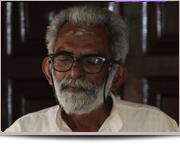

About Vinaya Chaitanya

Vinaya Chaitanya was born in Muvattupuzha the place of the three rivers in the foothills of the Western Ghats, before the invasion of rubber plantations, in 1952. He met and was accepted as a disciple by Dr Nataraja Guru (1895 1973), disciple and successor of Narayana Guru, the philosopher-poet of Kerala. He studied under Nataraja Guru in the gurukula, a worldwide contemplative community open to all.
While serving his guru as head of the Narayana Gurukula Institute of Aesthetic Values in rural Bangalore for forty years, Vinaya was fortunate to learn Kannada from minstrels who introduced him to the vacana, kirtanas and tatva forms of mystical poetry. Vinaya has published books in Malayalam, Kannada and English. He now continues the wisdom-sharing tradition of the gurukula without institutional affiliation, treating the whole world as his gurukula (family of the guru). Vinaya Chaitanya can be contacted through email-id: vinaya@unitiveunderstanding.org

Review by Kumar Rajappan, PhD
Narayana Guru was a teacher of wisdom, and it is through that wisdom the Guru transformed, for good,
the population of Kerala into a modern society that recognizes the true spirit and value of man without
regard for caste, religion, or personal belief. Swami Vivekananda would call the Guru’s approach as
practical Vedanta. People in different parts of the world will be celebrating the Gurus birthday soon,
followed by his death anniversary also. As time passes, people become complacent with status quo and
tend to slide into superstitions and discord with fellow humans and society. Ugly heads of caste
prejudices and religious hatred rise to make society cower under shame or fear. While this is becoming
more and more true in Kerala which has been by and large fortunate to experience the fruits of spiritual
and social renaissance the Guru initiated, much of India has not had the same opportunity to enjoy such
a revolution and its long-standing effects. It is not that others state or provinces haven’t had their share
of spiritual luminaries and Gurus, rather it is the unique methodology Narayana Guru used that made
the key difference. He was out in the world, among people, while remaining fully anchored in the Self
within and without (the Guru calls it ‘…the Word that fills both inside and outside, to the brim…’). A key
part of that methodology was the hymns, prayers, and philosophical poems of Upanishadic clarity and
quality he wrote for posterity. Every time the Guru installed a temple, he wrote a hymn praising the
presiding deity often blending Vedantic concepts in such way that the deity of common worship and
ecstatic supplication itself is elevated to the status of Absolute (Brahman). One such example is the
‘Nine-gemmed bouquet for the Mother’ which was composed on the occasion of installation of a temple
for Goddess Śārada, who is also called Sarasvati, the goddess of wisdom. Many such hymns, often
praising the deities of Siva traditions, even though the Guru’s first poems is on the ‘Vision of Sri Kŗșņa,’
are quite well known to people of Kerala. Apart from hymns, the Guru has composed five major
Vedantic texts that illuminate the depth and breadth of his philosophical vision. On the one hand these
resonate with the Upanishads in their vision of Oneness while from a closer scrutiny by a learned man
these encompasses the core philosophical concepts of the western tradition as well. For example,
Darsanamala (A Garland of Visions) composed in Sanskrit enables one to visualize an overall
epistemology (awareness), axiology (purpose) and methodology (practice) that can remove or mitigate
many a life’s dilemmas. It is within the context of self-awareness of the individual and the collective and
continuing program of social upliftment, without religious patronizing, political manipulations, and
pedantic doctrinal hairsplitting, that the Guru philosophy offers, a new English translation of the Guru’s
works, ‘A Cry in the Wilderness: The Works of Narayana Guru’ by Vinaya Chaitanya becomes relevant
and timely.
Vinaya Chaitanya has been immersed in the Guru Philosophy for the last 50 years. It has been his refuge
and meditation all through out his adult life. He got attracted to Nataraja Guru, a pre-eminent scholar
disciple of Narayana Guru, and accepted him as his preceptor. After the passing of Nataraja Guru, Vinaya
associated with Guru Nitya Chaitanya Yati, another great mystic, poet, and philosopher in the lineage of
Narayana Guru, and continued his study and meditation of the Guru wisdom from all angles, including
aesthetics, poetics, Western and Eastern philosophies, psychology, and Christian mysticism. And he is
not a novice in translating works of spiritual or metaphysical import either. He has translated ‘Songs for
Siva: Vacanas of Akka Mahadevi’ a twelfth century saint of Karnataka, into English, and Narayana Guru’s
works into Kannada. It is this continuous training, self-discipline, in depth knowledge of English and
Malayalam, and experiencing the wonder of the numinous that enabled him venture into translating the
Guru’s works. And what a great job he has done!
The title itself is catching and can be mistaken. This biblical idiom refers, in this context, to the dangers
of dividing and demeaning social mindset of casteism still prevailing in many parts of India in its raw
form and stunting its rise to the apex power such that it can be the true beacon of hope for mankind,
which once it was. Narayana Guru recognized and addressed the issues of casteism using simple tools of
Vedantic principles and dispelled it from the minds of millions of Keralites. He provided the theoretical
arguments for it through his works in Malayalam, Sanskrit and Tamil. This happened about a century ago
and yet much of India is unaware of this Jnanin of action and his works. This translation is meant to
overcome the limitation of language. Let us take an example of Vinaya’s lucid translation of the first
verse of ‘Nine-gemmed bouquet for the Mother.’ This work is highly spiritual, devotional, Vedantic, and
unusual in the poetic meter used (not many poets have written in mattebham meter in Malayalam).
Philosophical poems often suffer from dearth of poetic sweetness. But this work of the Guru in its
original is highly poetic. Vinaya Chaitanya has done a marvelous job in translating this without either
losing the spiritual meaning or the poetics. Of course, the meter cannot be accommodated in the
translation. Here is an example of the first verse:
From the one great mind, a thousand tri-petals come;
Self-awareness forgotten then, quickly, fondness for food and such arises;
My mind-source, as one, falls into the sea of sorrow and struggles;
To merge it in the realm of sound that gives birth to the onward path,
To mix and melt in that navel of consciousness, wherein appears spreading light;
That these triplets cease, and be cooled, when will it be, O Mother?
Here the devotee is asking the Goddess Mother the reason for us to suffer in the ocean of samsara
(cause and effect), even though the Mother itself is the womb of all that is manifested here. He is also
seeking a way out so that he can merge back into the source itself. The ‘tri-petal’ and ‘triplet’ refer to
the same consciousness differentiated into knower, known and knowledge or enjoyer, enjoyed and
enjoyment or any other similar combinations pertaining to actions like seeing, doing, experiencing etc.,
as three distinct sets without understanding the Oneness (Mother) as the source.
Another example from a much simpler poem of upliftment from ‘Ascertainment of Caste (Jāti
Ņirnayam)’ goes as follows:
Man is of one caste, one religion and one God,
Of one same womb, one same form, with no difference at all. (Verse 2)
That first line is one of the most quoted lines in Malayalam. One Hundred Verses of Self Instruction
(Atmopadesa satakam) is considered the magnum opus of the Guru, in which the philosophy as it
applies to individual and universal Self attains its sublime heights. It is here the Vedanta of Narayana
Guru resonates with that of Sankaracharya yet accommodates both the qualified non-dual Vedanta
(Vișishtadwaita) of Ramanujacharya and the dualistic Vedanta (Tathwavada) of Madwacharya. Vinaya
translates verse 22, where the Guru explains why an action that is good to one should be good to the
other also.
The other’s dear value, that is mine too, and
What is dear to me is the same to the other as well;
This is the way of wisdom; therefore, action that brings
Benefit to one should cause the good of the other. (Verse 22)
This reviewer is a man of science, yet I have been contemplating on the works of the Guru for the last 40
years, and I cannot tell how happy I am to see such a crystal-clear translation of the Guru’s works.
Poetics and philosophy blend in this work just as it is in the original. It is appropriate that the translator
chose to put ‘Embryo’s Gratitude’ as the first poem but putting ‘Thoughts on God (2)’ in the beginning
and its prelude, ‘Thoughts on God (1)’ elsewhere does not make much sense to a novice reader, even
though these can be justified by the structural secrets implied in the Guru’s works as taught by his most
learned (A doctorate with Triple Honors from Sorbonne, Paris) disciple, Nataraja Guru. Another
shortcoming I notice is the inconsistency in the use of lower/uppercases when referring to Self, Your,
Word etc. when these refer to the Absolute. A careful reader should be able to recognize these and
understand the references implied. I congratulate the translator for his tenacity and perseverance
(tapas) in bringing the Guru’s work to the English-speaking world, both in India and abroad. I further
appreciate the goodwill of Harper Collins to recognize the value of this translation and bring it out in
such a beautiful form.

About Dr. Kumar Rajappan (Vasanth)

Dr. Kumar Rajappan (Vasanth) is a Biotechnology scientist in the US. He has earned his PhD in Drug Discovery from the University of Maryland near Washington DC. He is a lifelong associate of Narayana Gurukula, a Guru Disciple organisation founded by Nataraja Guru, the principal exponent of the Guru's wisdom. He had the fortune to sit at the feet of Guru Nitya Chaitanya Yati and Guru Muni Narayana Prasad, the current head of Narayana Gurukula.
Vasanth is a continuing student of the Guru Wisdom. He resides in San Diego, California with his wife and two children. Dr. Kumar Rajappan can be contacted through email-id: kumarwayanad@gmail.com
